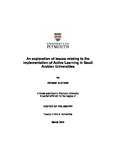An exploration of issues relating to the implementation of Active Learning in Saudi Arabian Universities
| dc.contributor.supervisor | Quinn, Jocey | |
| dc.contributor.author | Alotaibi, Fatmah | |
| dc.contributor.other | Faculty of Arts, Humanities and Business | en_US |
| dc.date.accessioned | 2019-07-23T13:11:01Z | |
| dc.date.issued | 2019 | |
| dc.identifier | 10331677 | en_US |
| dc.identifier.uri | http://hdl.handle.net/10026.1/14672 | |
| dc.description.abstract |
Saudi Arabia’s Vision 2030 is ambitious in its proposals for educational reform which includes the preparation of a modern curriculum focused on rigorous standards which will be aligned with a range of education outcomes Therefore, Saudi Higher Education laid the groundwork to develop and improve the educational aspects towards students and lecturers, as well as to adopt all new approaches in education. Accordingly, this study aimed to explore the perceptions of Saudi lecturers and undergraduate students towards learning approaches especially Active Learning (AL) when participating in active courses. The advantage of AL is that it may provide the Colleges and Universities with a mechanism by which improvements in educational outcomes are achieved. As the move to an AL model represents an essential shift in the Saudi education system, this study illustrates how Saudi students and lecturers reacted to this alteration and how it influenced the quality of their learning and teaching experience. The objective of the study is to classify Saudi undergraduate students and lecturers’ perceptions of the advantages, challenges and future of AL. Therefore, the vital factors that affect the lecturers’ and students’ views are discussed, and recommendations for future research, strategy and practice are provided. Qualitative methods were used to gain rich descriptive data to facilitate the exploration of the phenomena. Three qualitative approaches were used to gather the data: observations, focus group discussions, and in-depth interviews. The three different techniques made it possible to gather diverse forms of information. Three universities were selected to be investigated in this study: Umm Al-Qura University, King Saud University and Princess Nora bint Abdulrahman University. Using an interpretative approach, the data was analysed in the form of explanation and interpretation of the participants’ perceptions of active learning. The findings of this study indicate that there were many factors that impacted (both positively and/or negatively) on the process of using AL in Saudi Universities. The main factors identified by this investigation were leadership, national culture, training, and technology, and these influenced the adoption of AL both directly and/or indirectly. The results of this study reveal a distinct pattern in the adoption and use of AL in the participating universities, although the processes of implementation varied between them. A particular emphasis of this project was that AL offered heightened learning experiences and improved students’ understanding of their courses. The results of the data analysis, also, show that AL has not yet been fully or adequately implemented in Saudi universities, and so far, it has not received an official endorsement as educational policies at other levels of the educational system. As there are always challenges of adaptation when a new method is employed, this research offers a vision into how the challenges of implementing AL in Saudi Higher Education could be addressed. An AL model is introduced to offer the factors that affect the implementation of active learning. | en_US |
| dc.description.sponsorship | Saudi Embassy | en_US |
| dc.language.iso | en | |
| dc.publisher | University of Plymouth | |
| dc.subject.classification | PhD | en_US |
| dc.title | An exploration of issues relating to the implementation of Active Learning in Saudi Arabian Universities | en_US |
| dc.type | Thesis | |
| plymouth.version | publishable | en_US |
| dc.identifier.doi | http://dx.doi.org/10.24382/1180 | |
| dc.rights.embargodate | 2020-07-23T13:11:01Z | |
| dc.rights.embargoperiod | 12 months | en_US |
| dc.type.qualification | Doctorate | en_US |
| rioxxterms.version | NA | |
| plymouth.orcid_id | https://orcid.org/0000-0001-8518-5718 | en_US |
Files in this item
This item appears in the following Collection(s)
-
01 Research Theses Main Collection
Research Theses Main


